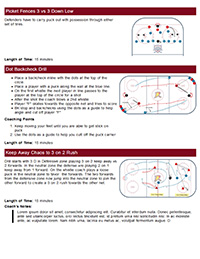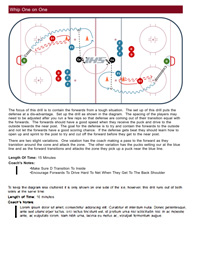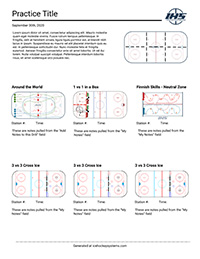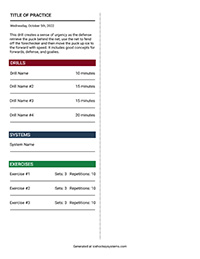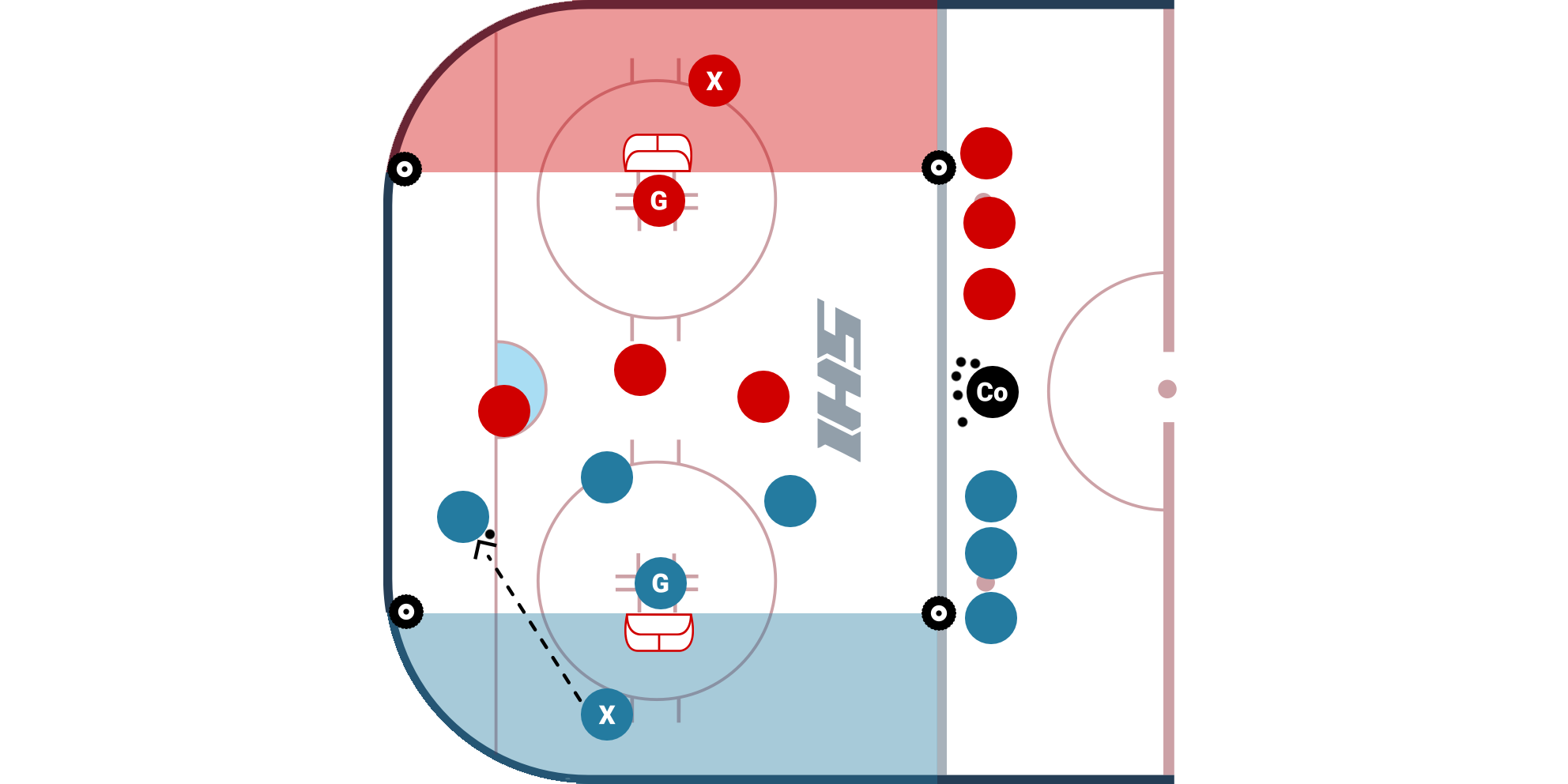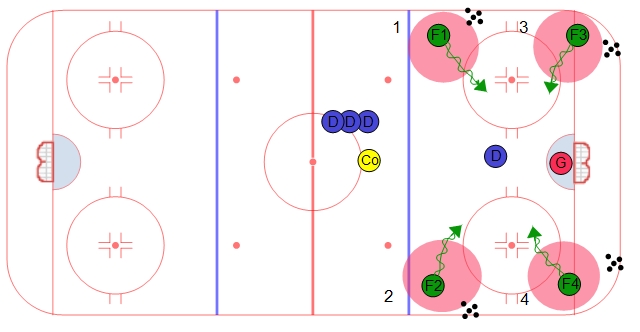
Träning 20211115
Träning 20211115

Rondo Circle Passing Progression
The Rondo Circle Passing Progression from Coach Alyssa Gagliardi is a great activity that can be used as a passing warm-up, or as an activity to improve overall awareness and passing with your head up. Rondos are popular activities in soccer. Rondo games are similar to keep away, where a group of players work to keep possession of the puck / ball.
Progression Details
- Setup: Can use 6 to 8 players around a circle.
- Part # 1 - One Puck Passing: Players work to pass one puck around the circle to all of the players. More skilled groups can work on one-touch passing, sauce passing, or backhand passing.
- Part # 2 - Two Puck Passing: Players work to pass two pucks around the circle. This requires more awareness as players need to pay attention to both pucks.
- Part # 3 - One Puck Follow Your Pass: Players make a pass and follow their pass to the player they passed to.
- Part # 4 - Two Puck Follow Your Pass: Players make a pass and follow their pass to the player they passed to. This requires more awareness and players to keep their head up since there will be two pucks and people skating in the middle of the circle.
- Part # 5 - One Person Keep Away: Players work together to pass the puck and play keep away from a player in the middle. If the player in the middle steals the puck, they will become a passer and the player that passed the intercepted puck will go in the middle to become the defender. Coaches can rotate defenders if they are in the middle for 15+ seconds.
- Part # 6 - Two Person Keep Away: Players work together to pass the puck and play keep away from the two players in the middle. If a player in the middle steals the puck, they will become a passer and the player that passed the intercepted puck will go in the middle to become the defender.
- Part # 7 - Two Person Keep Away to 2 on 1: Players work together to pass the puck and play keep away from the two players in the middle. When the defenders steal the puck, it initiates a 2 on 1, where the 2 defenders now go on the offense and the player that passed the intercepted puck becomes the defender on the 2 on 1.
Coaching Points
- When passing, players should keep their hands away from their body and chest so they can pull with their top hand and push with their bottom hand.
- Players without the puck should keep their stick on the ice and give their teammates a target to pass to.
- When playing keep away, the players that are passing should work on deception by using their body language (hands, eyes, and body) to trick the defender and make them think they will be passing somewhere else.
Variations
- Coaches can set this up in different areas of the ice.
- Coaches can do this rondo progression with 4 to 8 players.
- Players can work on forehand, backhand, one-touch and sauce passes.
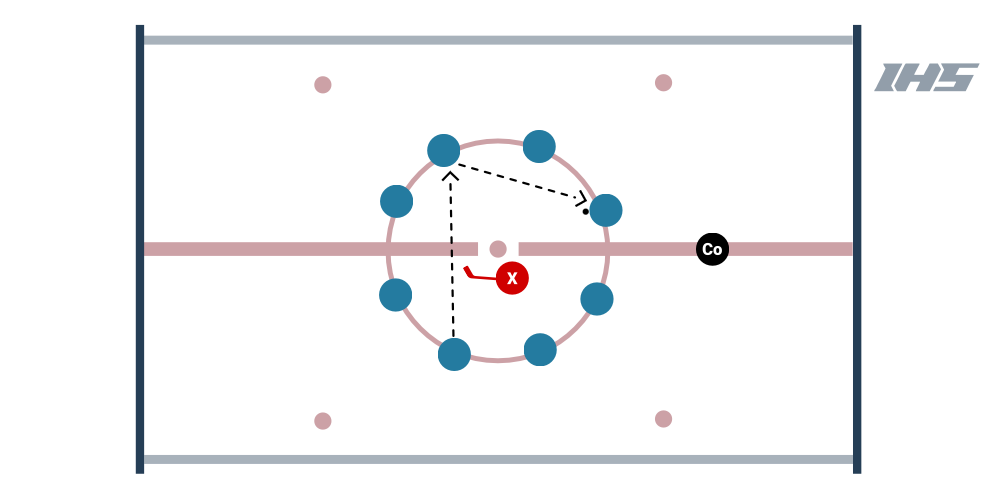
Four Zone 1 on 1
This drill can be very challenging for defensive players. The drill forces players to work on taking away time ans space in the defensive zone, recovering from a disadvantageous position, and stamina.
To set up the drill place four lines of players in each corner of the zone with pucks as shown in the diagram. The coach will name each line 1,2,3, or 4. Make sure all players are fully aware of the label for each line. The defensive player will start in the middle.
To start the drill the coach yells out a number. The first player in that line will attack the net. The defensive player has to react and play the 1 on 1. On the whistle, that play stops and the coach yells out a new number from which the next player attacks the net 1 on 1. This sequence repeats 4 times so that the defensive player plays four 1 on 1's, one out of each zone.
Catch and Release
This drill is greared towards forwards and goalies. It is a simple drill that focuses on one of the more important skills that all goal scorers seem to have, a quick catch and release. The forward start close to the coach in the middle of the ice and skates as fast as they can around the cone. The coach give the player a pass as they are going around the cone. The player is to catch the pass and release the shot in one motion. NO STICKHANDLING! Once the shot is taken then the next forward from the other line goes. Do about 5-6 repetitions and then let the goalie get a short rest. This will be challenging for most players but it is a great skill to have.
Feed Or Lead
The Feed or Lead hockey drill is a high tempo drill that works on passing, jumping to open space, receiving a pass from the corner and firing a quick shot on net in a high percentage scoring area. This drill gives coaches the opportunity to teach players about "Feed" hockey passes and "Lead" hockey passes. The basic descriptions are listed below:
- Feeds are passes that allow a player to quickly get a shot off.
- Leads are passes that allow the player to keep moving with forward momentum.
Setup:
- One net is placed at the normal crease area and a second net (or obstacle) is set up at the top of the circle.
- Player 1 skates up the boards and does a tight turn (protecting the puck) along the boards and passes to the next player in line (Player 2).
- Player 2 passes the puck back to Player 1 while Player 1 pivots up ice.
- Player 1 passes the puck back to Player 2.
- Player 1 jumps to open space around the net (or obstacle) and gives Player 2 a target to hit.
- Player 2 uses their hockey IQ to identify what hand they are (left or right) and where to hit them with a feed pass so Player 1 can quickly get a shot off.
Coaching Points:
- Player 1 should work on verbal and non-verbal (eyes, stick & body language) communication.
- Player 1 should focus on jumping to open space quickly and getting a quick shot off.
- Player 2 should identify the best place to give Player 1 a pass.
Variations:
- Add in an obstacle or a defenseman (that is static) into the slot area so that Player 1 & 2 can work together to determine if a Feed pass or Lead pass is best. A Lead pass would be helpful to get around a defenceman or obstacle.
- If you use a static defenceman in the slot, they can move their stick in front of them or behind them just as Player 1 is coming around the net which will force both Player 1 and 2 to communicate the best place to pass to.
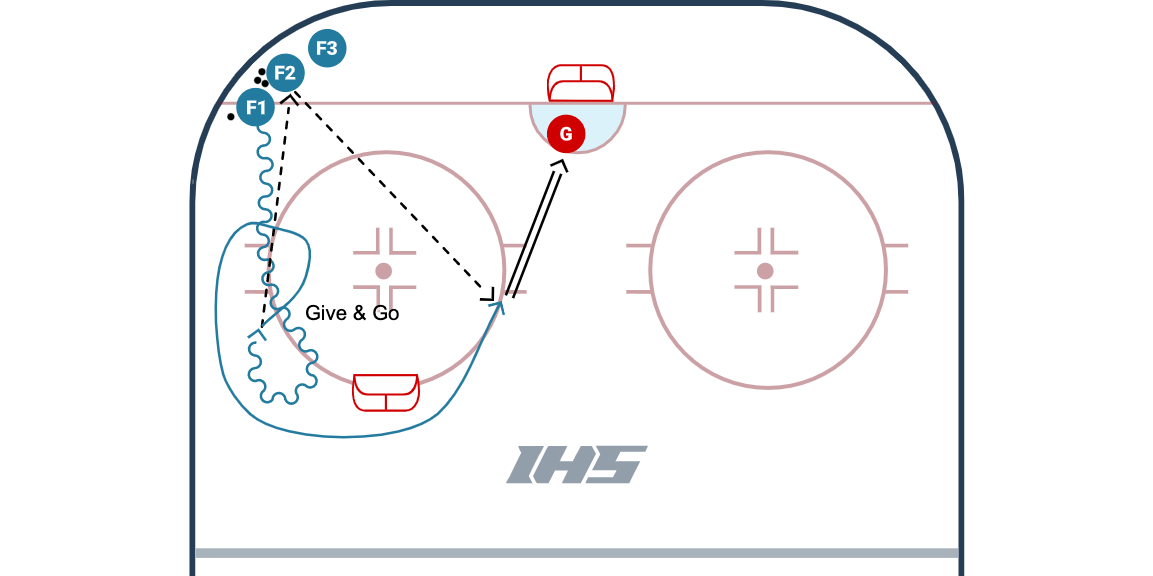
Attack in O-zone
This drill has two players active at the same time. It works on passing, attacking the zone, hip opening, shooting and blocking the goalie or tipping the shot.
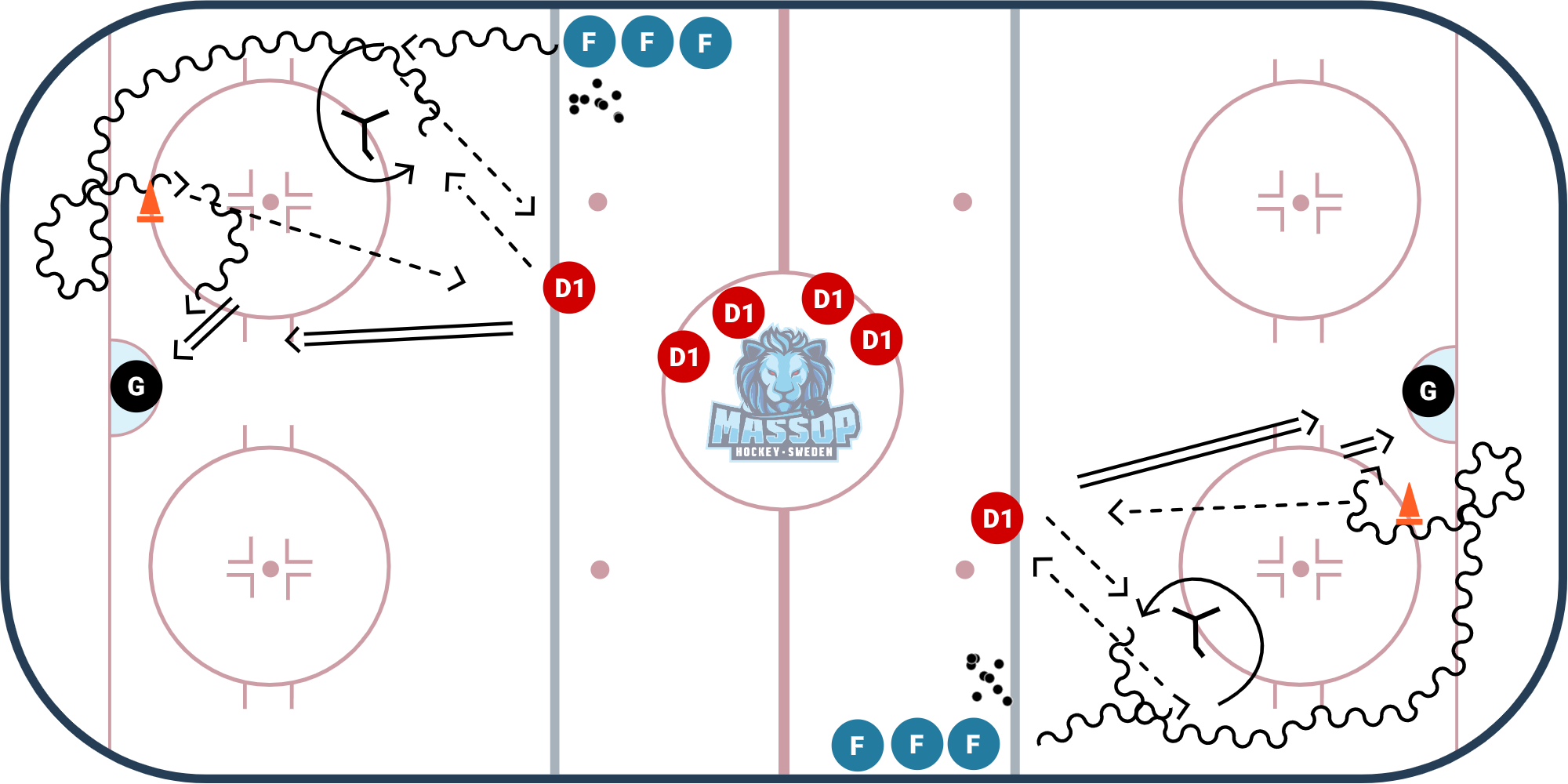
Continuous 3 vs. 3
Start the drill with 3 vs. 1. When the puck moves past the red line then the remaining 2 defenders backcheck into their own zone. 3 vs. 3 continues in the zone until either a goal is scored or the defending team breaks out the puck Max 45 seconds. When the defending team breaks out of their own zone they work towards the opposing teams goal where 1 defender is already waiting in the neutral zone (3 vs. 1) agin when the puck passes the red line the remaining two defenders back check.
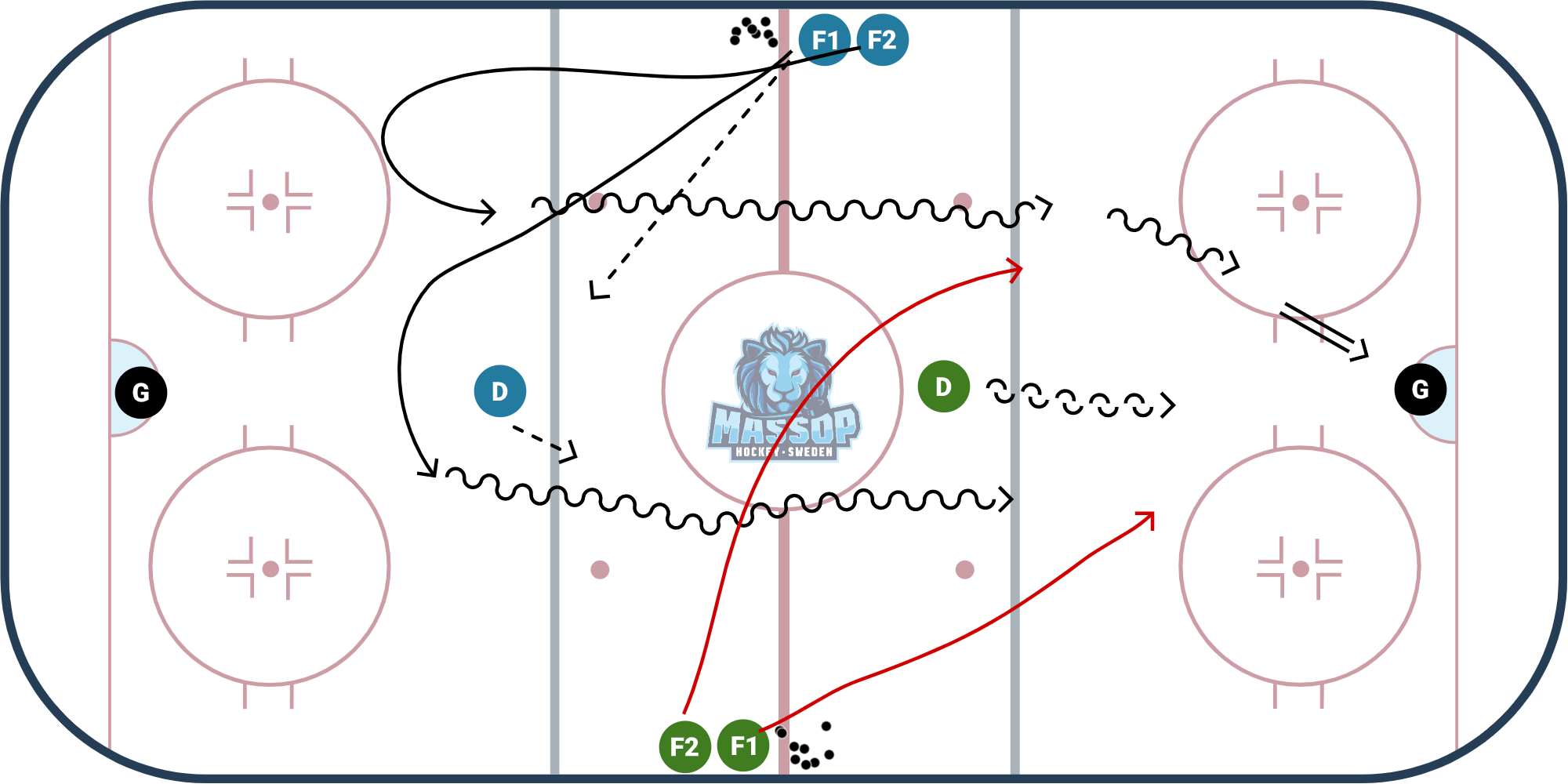
Bourque 3 on 3 Game
The Bourque 3 on 3 cross ice game is similar to the Gretzky Game but now the designated passers behind the nets are referred to as "Bourque." The "Bourque" is behind their own goal line and helps to initiate breakout passes to their teammates. It is important that players regroup to support their "Bourque."
Game Rules
- Players must use their "Bourque" on a change of possession before making an attempt to score.
- Players may attack the other team's "Bourque" but they may not shadow them.
- Players that are playing in the 3 on 3 can go behind their own goal line to help out their own "Bourque".
- There is no limit to how often a team uses their "Bourque."
- Shifts should be 30 - 40 seconds to keep a good pace and high intensity.
- If a puck goes out of play, the coach can dump in a new one.
Coaching Points
- Have the "Bourque" work on a good first pass.
- Use "false Information / deception" (fakes & looking off the pass) to get their players open.
- Players need to skate back to support their "Bourque."
- Fill three lanes and skate to open ice.
Variations:
- Can be 3 on 3 or 2 on 2.
- Can have 2 Bourque's to allow for D to D passes before the breakout starts.
